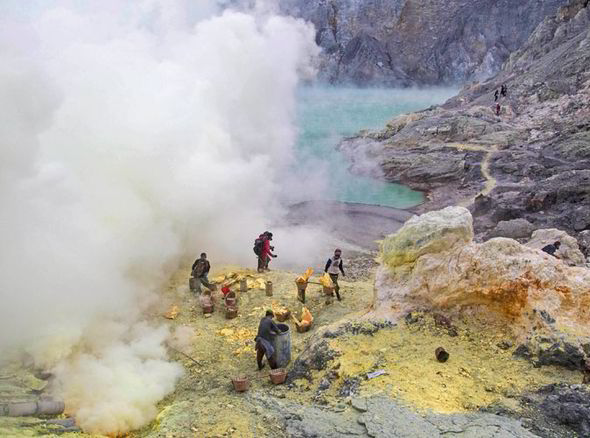
In Friday’s blog I talked about the most dangerous jobs in terms of actually dying from accident or injury. These are acute incidents. But exposure over time—what I’m calling chronic hazards—can be just as deadly, often with prolonged pain and suffering.

In truth, it isn’t always an either/or situation. If they are combined, being President of the United States is the deadliest job in the country. To date, 8 of the 45 presidents have died in office: 4 were assassinated and 4 died of natural causes.
The ill effects of exposure over time is the focus here.
Heavy metals

“Heavy metals” and metal compounds are notoriously harmful to people’s health. Some toxic, semi-metallic elements, including arsenic and selenium, are as well. In very small amounts, many of these metals are necessary to live. However, in larger amounts, they become harmful by building up in the body’s systems. People were dying from such exposures long before they knew the causes or had explanations. Of the 35 metals that are of concern because of residential or occupational exposure, 23 are heavy metals. Here’s a partial list.
Arsenic
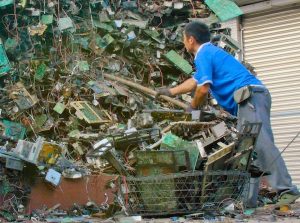
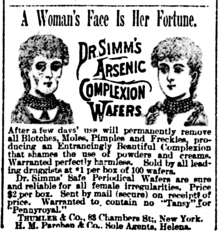
Common sources of exposure to higher-than-average levels of arsenic include working near or in hazardous waste sites or in areas with high levels naturally occurring arsenic in soil, rocks, and water. Arsenic released by human activities is triple the exposure from natural sources. Most paints, dyes, soaps, metals, semiconductors, and drugs contain arsenic. Some animal feeding operations, pesticides, and fertilizers also release arsenic to the environment.
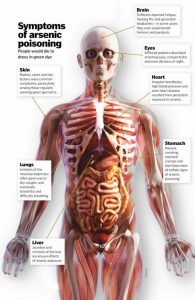
Occupations with high exposure:
- Alloy manufacturing
- Carpentry
- Chicken and swine farming
- Electronic manufacturing technicians
- Electronic waste disposal
- Pesticide, insecticide, and/or herbicide applicators
- Smelter operator or engineer
- Glass manufacturing
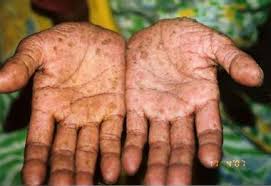
Symptoms of lower arsenic exposure include nausea and vomiting, reduced production of erythrocytes and leucocytes, abnormal heart beat, pricking sensation in hand and feet, damage to blood vessels. Prolonged exposure leads to skin lesions, internal cancers, neurological problems, pulmonary disease, peripheral vascular disease, hypertension, cardiovascular disease, and diabetes mellitus (Type 1 and 2). Many of the effects are irreversible. There is no effective treatment for arsenicosis. Exposure to high levels of arsenic can cause death.
Beryllium

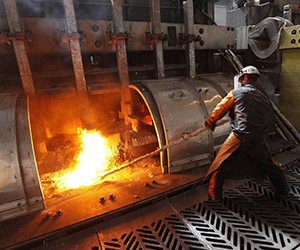
Elemental beryllium has a wide variety of applications. Occupational exposure most often occurs in mining, extraction, and in the processing of alloy metals containing beryllium.
Industries and occupations include:

- Aerospace
- Automotive parts
- Computers
- Construction trades
- Dental supplies and prosthesis manufacturer
- Electronics
- Industrial ceramics
- Laboratory workers
- Metal recycling
- Mining of beryl ore
- Nuclear weapons
- Precision machine shops
- Smelting foundry
- Tool and die manufacture
- Welding
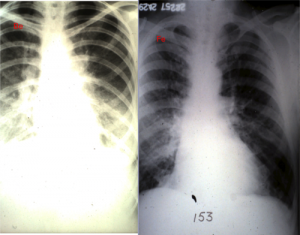
Beryllium causes sensitization and lung and skin disease in a significant percentage of exposed workers.
Cadmium

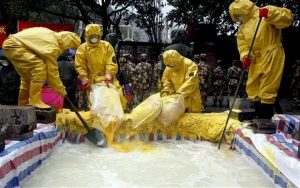
Cadmium is an extremely toxic metal commonly found in industrial workplaces, particularly where any ore is being processed or smelted. Several deaths from acute exposure have occurred among welders who have unsuspectingly welded on cadmium-containing alloys or with silver solders. Beware jewelry makers!
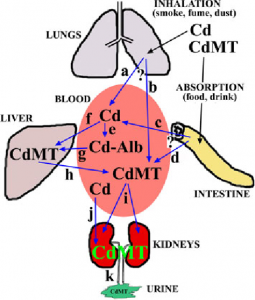
Cadmium and its compounds are Group 1 carcinogens as classified by the International Agency for Research on Cancer. It can cause both acute and chronic effects: high toxic to kidneys, bone mineralization, osteoporosis, lung damage. Smokers are more susceptible to cadmium intoxication. The biggest contributor to human cadmium exposure is fossil fuels, 33%.
Hexavalent Chromium

When chromium is in a valence state (+6 oxidation), it becomes hazardous to health. Calcium chromate, chromium trioxide, lead chromate, strontium chromate, and zinc chromate are known human carcinogens. An increase in the incidence of lung cancer has been observed among workers in industries that produce chromate and manufacture pigments containing chromate.

Such exposure is likely in these jobs and industries:
- Welding and other types of “hot work” on stainless steel /other metals that contain chromium
- Use of pigments, spray paints, and coatings
- Leather tanning
- Operating chrome plating baths

Besides cancer: when broken skin comes in contact with any form of chromium compound, a deep hole will form; also targets respiratory system, kidneys, liver, and eyes.
Lead

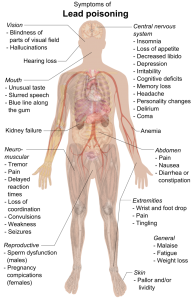
The brain is most sensitive to lead poisoning. Symptoms may include abdominal pain, constipation, headaches, irritability, memory problems, inability to have children, and tingling in the hands and feet. It causes almost 10% of intellectual disability of otherwise unknown cause and can result in behavioral problems. Some of the effects are permanent. In severe cases anemia, seizures, coma, or death occur.
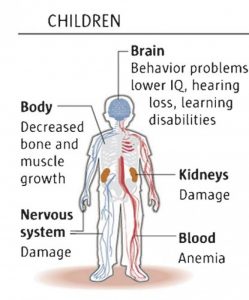
Occupational exposure to lead is one of the most prevalent overexposures. Industries with high potential exposures include:
- Construction work
- Most smelter operations
- Radiator repair shops
- Firing ranges

Outside the workplace, the main sources of exposure to lead occur from contaminated air, water, dust, food, industrial emissions, and soil, or consumer products such as paint, gasoline, toys, and cosmetics. Lead-based makeup was used in Ancient Greece, but became especially popular when Queen Elizabeth I started using it to hide her chickenpox scars. It killed her. Symptoms prior to death include hair loss, skin welts, and inflammation of the eyes.
Mercury

As far as I can find, all forms of mercury are hazardous. Common occupational sources of mercury exposure include:
- Mining, production, and transportation of mercury
- Mining and refining of gold and silver ores
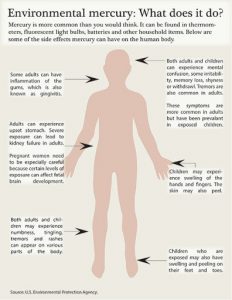
High mercury exposure results in permanent nervous system and kidney damage. Depending on the specific form of the mercury, symptoms include shyness, tremors, memory problems, irritability, and changes in vision or hearing; lung damage, vomiting, diarrhea, nausea, skin rashes, increased heart rate or blood pressure; depression, memory problems, fatigue, headache, hair loss, etc.


Mercury poisoning—a.k.a. mad hatters disease—wasn’t nearly as fun as the tea parties in Alice in Wonderland. Mercuric nitrate, used to make felt, is extremely toxic, and breathing the fumes all day, every day resulted in uncontrollable twitches and tremors, as well as emotional changes, mental decline, kidney trouble, and respiratory failure. As early as 1757, a French physician noted that hat makers seldom lived beyond 50 years, and suffered ill health long before that.

Pregnant women are advised to limit their consumption of fish, especially fatty fish because of mercury buildup.
Toxic Exposures That Aren’t Metals At All
Anthrax

The bacterium Bacillus anthracis causes anthrax, usually lethal to humans. Inhalation anthrax is caused by breathing in spores and has an especially high fatality rate. Person to person spread is rare.
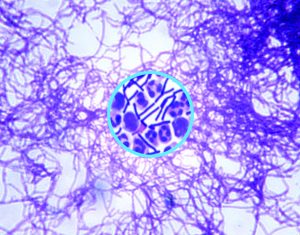
Anthrax infections occur naturally in wild and unvaccinated domestic animals. It is contracted primarily from livestock—which is another way farming, ranching, and large-animal veterinary practice can be hazardous to your health.
Asbestos

Asbestos is actually a group of naturally occurring minerals that are resistant to heat and corrosion. Things made of asbestos will not burn—and therein lay its appeal.

Ancient Greeks and Romans knew about it. By the 1850s, French firefighters wore uniforms of asbestos cloth. In the period of hoop skirts, asbestos fabric seemed the perfect solution to skirts ignited by open flames.
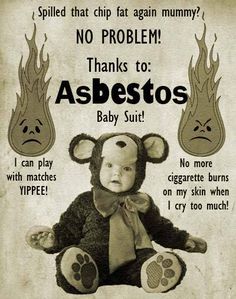
Men who mined the ore, women and children who prepared and spun the raw fibers into cloth, all developed asbestosis, scarring of the lungs. This led to chronic shortness of breath, increased risk of some cancers, and eventual death.

Asbestos is a heat-resistant fibrous silicate mineral. Besides being woven into fabrics, it is used in fire-resistant and insulating materials. Brake linings, pipe insulation, and house shingles were common uses for asbestos.

Heavy exposures tend to occur in the construction industry and in ship repair, particularly during the removal of asbestos materials due to renovation, repairs, or demolition. The recent implosion of the Dominion building in Richmond is one example. It was in need of renovation and building a new building was less expensive than trying to remove the asbestos.
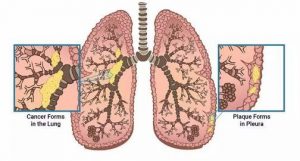
Asbestos is well recognized as a health hazard and its use is now highly regulated by both OSHA and the EPA.
Formaldehyde
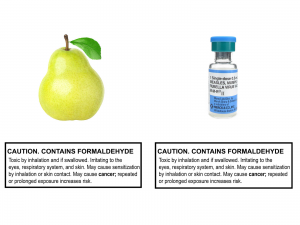
Previously mentioned in the context of harmful clothing, formaldehyde is a chemical (composed of carbon, hydrogen, and oxygen) formed when burning methane. It is used to make other chemicals, as a disinfectant, and as a preservative. In spite of numerous adverse effects, it’s still widely used.
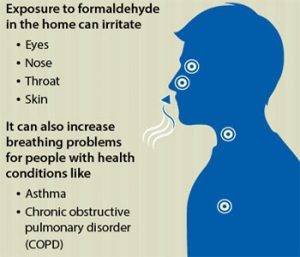
Formaldehyde poisoning is caused by breathing the fumes, either by working directly with it or using equipment cleaned with it. It can also be absorbed through the skin. Short-term effects include eye, nose, and throat irritation, headaches, and/or skin rashes. Long term, it is well known to be a human carcinogen. Workers exposed to formaldehyde, such as funeral directors and embalmers, are at increased risk of leukemia and brain cancer.
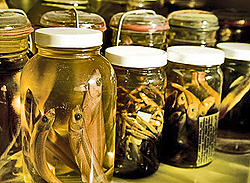
Inhaling above 50ppm concentration of formaldehyde can cause severe pulmonary reactions within a short period: pneumonia, bronchial irritation, and pulmonary edema. Lower concentrations cause coughing, wheezing, and bronchial asthma, sore throat, and red irritated eyes.
Ionizing Radiation

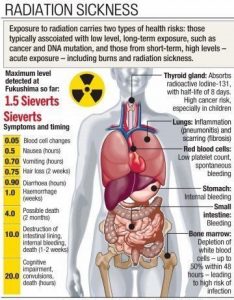
Natural sources of ionizing radiation include radon and uranium. Types include alpha- and beta-decay, X-rays, and gamma rays. They can strip atoms of electrons, damaging DNA. At high enough levels, it kills instantly.
Occupational settings with ionizing radiation:

- Medical and dental offices (X-rays)
- Hospitals and outpatient treatments centers (radiology, computed tomography, nuclear medicine, radiation oncology, interventional fluoroscopy or radiology, cardiac angiography
- Veterinary facilities
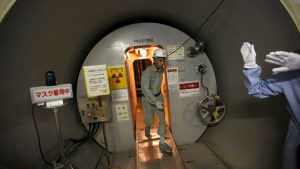
- Nuclear power plants and their support facilities
- Nuclear weapons production facilities
- Industrial operations (testing materials or products)
- Research laboratories
- Manufacturing settings and construction
- Air and space travel and transport operations, especially at high altitude
- Fracking for oil and gas well development
Radium


All isotopes of radium are highly radioactive. Radium, in the form of radium chloride, was discovered by Marie and Pierre Curie in 1898. It glowed, and quickly became popular in Europe. Various companies produced radium-based luminescent paint. It was used to make glow-in-the-dark instrument panels and watch dials, among other things. Women and girls (as young as 11) were hired to paint the watch faces, and were encouraged to twirl the brush tip between their lips to get the finest, most precise point—and with each lick of the brush, they swallowed radium.
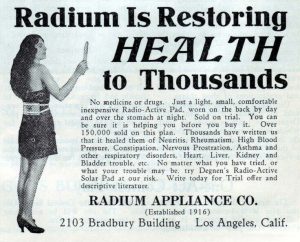
Some of the girls had a bit of fun with it, painting their nails, teeth, etc. just because who wouldn’t want to glow in the dark? Between the paint ingested and applied and radium dust in the factories, soon the workers glowed as they walked down the street. Radium was in their clothes and under their skin.
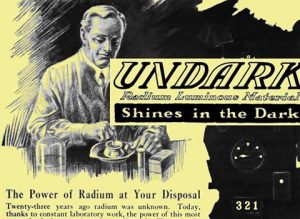
Early research using radium to kill cancer cells had been a success, and soon the public thought radium was a cure-all. Doctors started experimenting with it for everything from tuberculosis to lupus, and quacks started touting products for acne, baldness, impotence, and insanity.
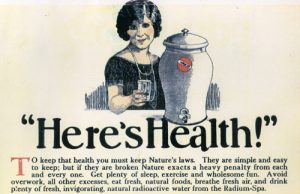
LD Gardner began marketing a health water he called Liquid Sunshine. The market was flooded with radium toothpaste, cosmetics, children’s toys, and theatrical costumes. Fortunately for consumers, radium was so expensive that many products didn’t contain real radium.
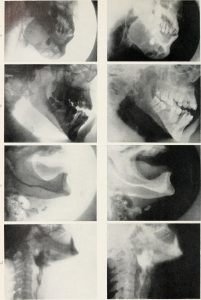
When workers got sick, they got sick slowly. Most of the girls became truly ill in their 20s. Radium is absorbed into the bones just like calcium, and then the rot starts. Some suffered chronic exhaustion first. But for many, it started with teeth falling out one by one. When rotten teeth were removed, their gums wouldn’t heal. Sometimes the jaw disintegrated at the dentist’s touch. Not surprisingly, bad breath was common. Skin became so thin that the slightest touch would cause open wounds. Skin ulcers formed for some. Pregnant women had stillborn babies. Death came slowly and painfully. Bones became honeycombed and crumbled, limbs were amputated, the girls became anemic, bedridden, and unable to eat.

By the late 1930s, enough were dead or dying that they got national attention—but never did they get compensation. One controversy was over whether all of this was caused by radium: how could one element cause such diverse problems?
Because it is so good at killing cells, today the Royal Society of Chemistry says the only appropriate use for radium is targeted cancer treatments.
VISCOSE
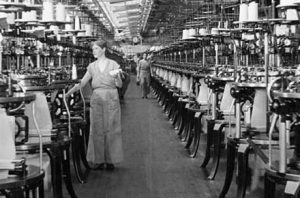
Viscose is a thick orange-brown solution made by treating cellulose with sodium hydroxide and carbon disulfide. It’s used as the basis for making rayon and transparent cellulose film.
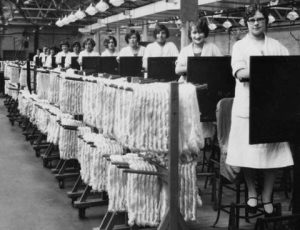
It was developed in the early 1900s. Fumes emitted during manufacture drove workers insane. They suffered horrific bouts of mania. Historian Alison Matthews David said that one factory put bars on the windows so “workers, demented from carbon disulfide exposure, would not jump out.” Such exposure also leads to Parkinson’s disease.
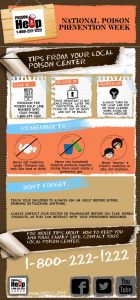
Many household products contain chemicals which may be harmful to the environment or hazardous to your health if inhaled, ingested, or absorbed through the skin. They should be used and disposed of according to instructions on the packaging. Common examples include:
- Drain cleaner
- Laundry detergent
- Furniture polish
- Gasoline
- Pesticides
- Ammonia
- Toilet bowl cleaner
- Motor oil
- Rubbing alcohol
- Bleach
Writers: Consider all the ways occupational exposure to these products could be harmful to janitors, maids, housecleaners, etc. Consider how they might be used to cause intentional harm. And consider how they might bring serious harm to toddlers.
Self-Destruction

Sometimes the job does not cause death in a direct way but by creating such stress that the employee turns to self-destructive behaviors.
Suicide

Nothing says self-destruction like taking one’s own life. From 2000 to 2016, the suicide rate in the U.S. population of working age (16-64) increased by 34%. Suicide rates for employed men are three times higher than for women. FYI: the occupations with the lowest suicide rates are education, training, and library. The Bureau of Labor Statistics uses only 23 classifications of occupations; thus, for example, college teachers and library archivists are lumped together.
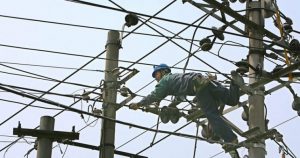
Among the BLS categories, the one with the highest suicide rates for men was construction and extraction. This includes everyone from boilermakers to electricians to hazardous materials removal workers.

For women the category was arts, design, entertainment, sports and media. This category includes everyone from artists to singers to athletes to court reporters. I find these categories too broad to be helpful. Unfortunately, there doesn’t seem to be a more refined basis for comparison.
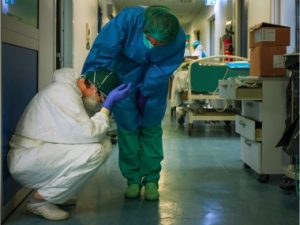
In 2018, according to an article in PhRMA, American health-care workers were committing suicide in unprecedented numbers. Some are expecting a tsunami of suicides caused by the COVID-19 crisis.
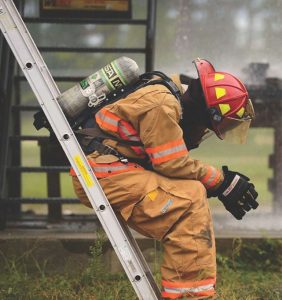
Police officers and firefighters are more likely to die by suicide than in the line of duty. Their depression and PTSD rates are five times higher than within the general civilian population.
Alcohol Abuse
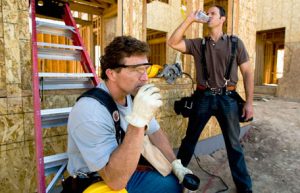
The top three professions with heavy alcohol use are (1) mining, (2) construction, and (3) the accommodation and food services industry. Arts, entertainment, and recreation are 4th.

A 2012 study in JAMA found that 25.6% of female surgeons and 13.9% male surgeons showed symptoms of alcohol addiction. These surgeons were more likely to report feeling burned out or depressed, and/or to have made a major medical error within the previous three months.

Among lawyers 29% in their first decade of practice report problem drinking behavior; 21% of lawyers in their second decade of practice have alcohol use disorders. Lawyers in law firms abuse alcohol at the highest rate. Overall, 33% drink problematically, 28% suffer from depression, and 19% exhibit symptoms of anxiety.
Drug Use/Abuse
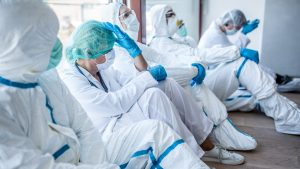
An estimated 10% of health care professionals abuse drugs, about the same as the general population. However, doctors are more likely to abuse/misuse prescription drugs than their patients. They use prescription drugs to manage physical pain, emotional distress, and stressful situations. Psychiatrists and emergency room doctors used drugs most, surgeons and pediatricians the least.
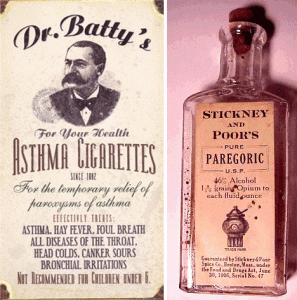
Accommodation and food service workers leads all other industries in past-month illicit drug use and past-year. There is no one drug these workers abuse most, including both depressants and stimulants.
Miners are more likely to use illicit drugs (5%) than opioids (1%).
Smoking
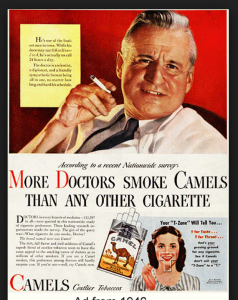
The highest prevalence of smoking was among workers in the accommodation and food services industries (28.9%), followed by construction (28.7) and mining (27.8%). The lowest rates were in education services (9.2%).
COVID-19 Adds Hazards
Current circumstances have made already hazardous jobs worse; professions that used to be relatively safe now carry a constant risk of infection. Similar shifted dynamics have occurred with pandemics throughout history, though the specific risks and professions vary.
Workers With Added Risk
Many professions already at risk for acute or chronic health problems are experiencing even more danger. Here are a few of the workers society has finally started to recognize as essential to function in the face of

Healthcare: Nearly every member of the healthcare profession has added stress now, whether from direct contact with infected patients or from increased workload as their colleagues shift to other departments or fall ill themselves. Separation from family and friends to avoid spreading infection adds to the mental strain as well as removing one of the major sources of relief. Add in longer hours and the very real threat of becoming infected, and it’s no wonder mental health experts are predicting a sharp increase in suicides and PTSD among healthcare workers. These extra health hazards are affecting everyone from home health aids to hospital janitorial staff.

First Responders: Paramedics and Emergency Medical Technicians face all the risks associated with healthcare work, but they also have to work in extremely high-stress situations. Firefighters, police officers, medical pilots, National Guard, dispatchers, emergency chaplains, etc. now face the additional risk of infection in every interaction they have with the public. Budget cuts in many areas have caused layoffs, adding extra stress and longer hours for other employees. Firefighters, who often double as medics, generally spend 24-48 hour shifts in close quarters when not responding to calls.

Food Production: Employees at every stage of the chain producing food for tables are facing added risks of infection and added workload. The people who harvest crops (already backbreaking work in its own right) often face the additional health threats of close living conditions, lack of access to regular medical care, and frequent moving among regions.

Employees at meat processing plants face similar external health risks, with the additional infection burdens of longer shifts in close-packed factories, and a lack of sufficient personal protective equipment. Some of these people have been ordered to continue working in the face of Health Department concerns and their own fears for their health.

Cargo Transportation: Relatively empty roads reduced the risk of vehicle collisions temporarily, but drivers faced added risks from longer hours, longer routes, and additional delivery pressure. For every driver who becomes sick or stops driving to take care of family members, other drivers take on additional work to cover routes. In addition, drivers now face a risk of infection at every pick-up, delivery, and rest stop.
Workers With New Risk
Many careers formerly considered relatively safe now come with risks entirely the result of the pandemic. Massive layoffs have put extreme performance pressure on remaining workers as well as adding the constant risk of economic uncertainty. Those deemed “essential” to the continued functioning of society as we know it often face threats of retaliation if they don’t remain at work. And still, these careers tend to be among the lowest-paying jobs in the US economy. They often lack proper safety equipment, paid sick leave, adequate health care, childcare options, and numerous other ways to mitigate risk and stress for themselves and their families.
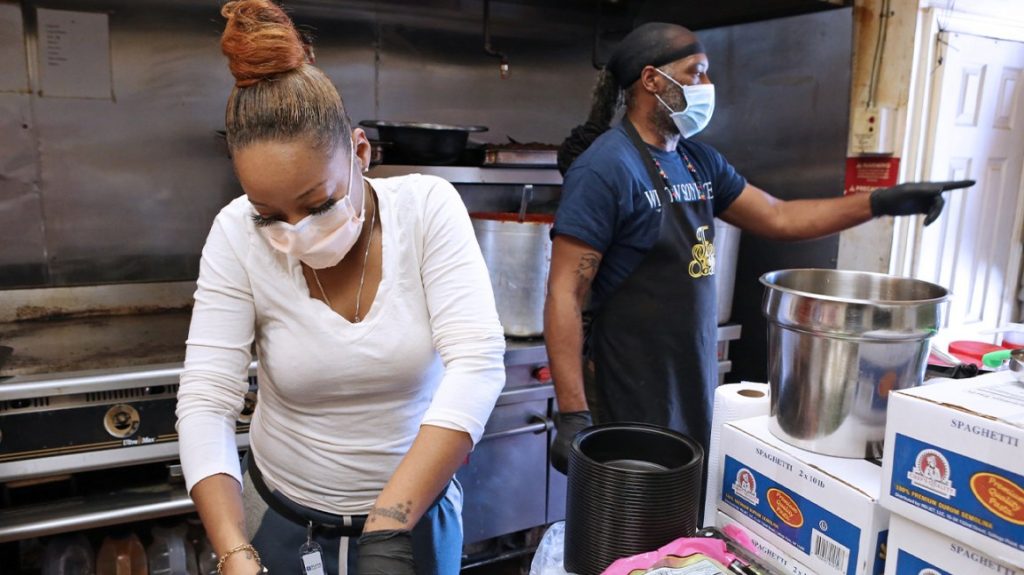
Food Preparation 
Retail Grocery 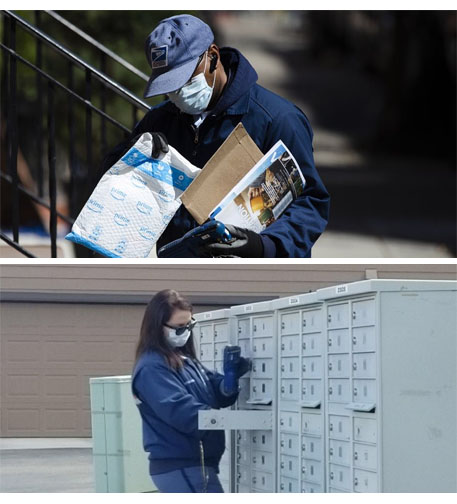
US Postal Workers 
Mass Transit 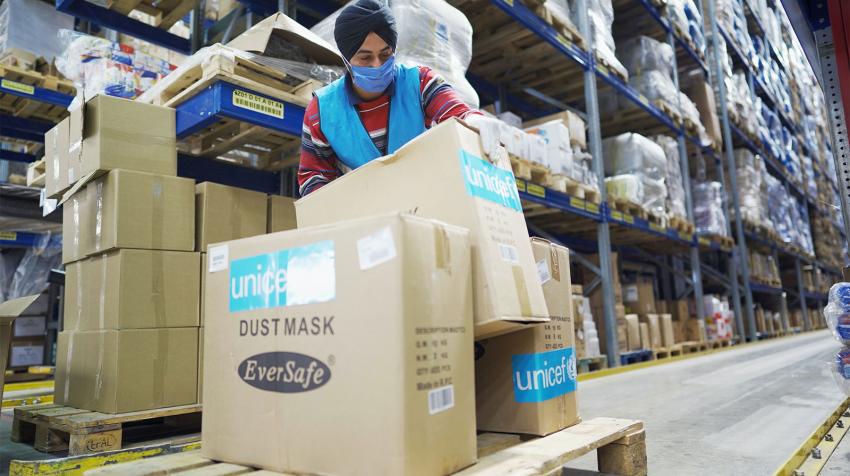
Warehouse Employees 
Home Delivery 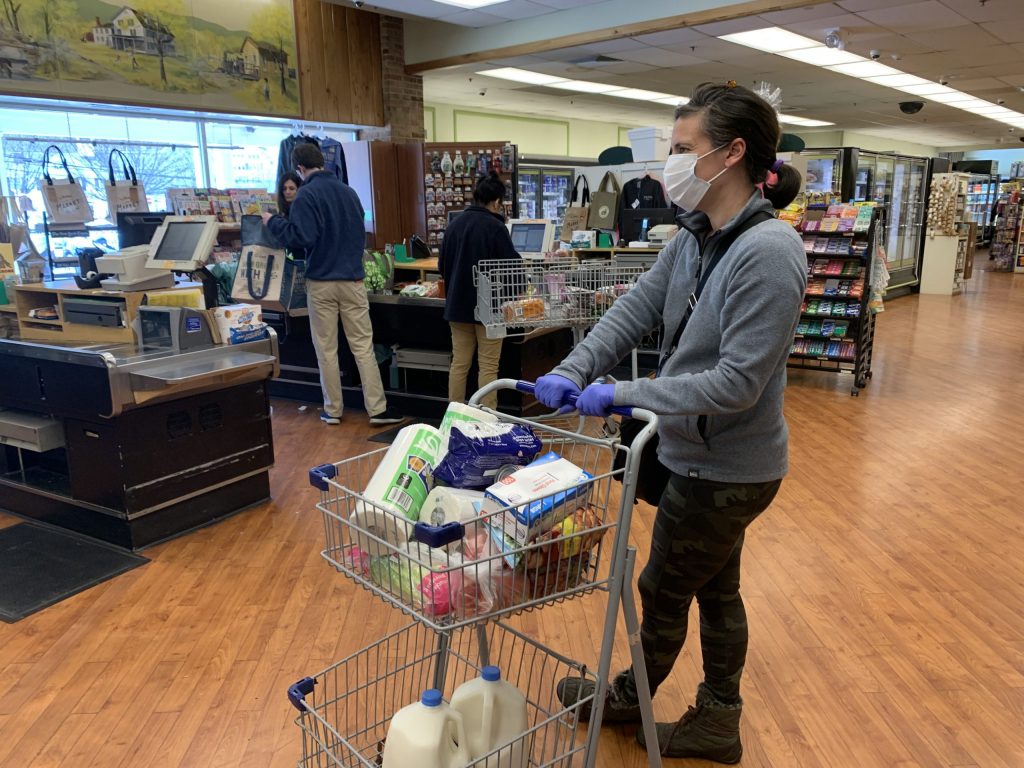
Proxy Shoppers 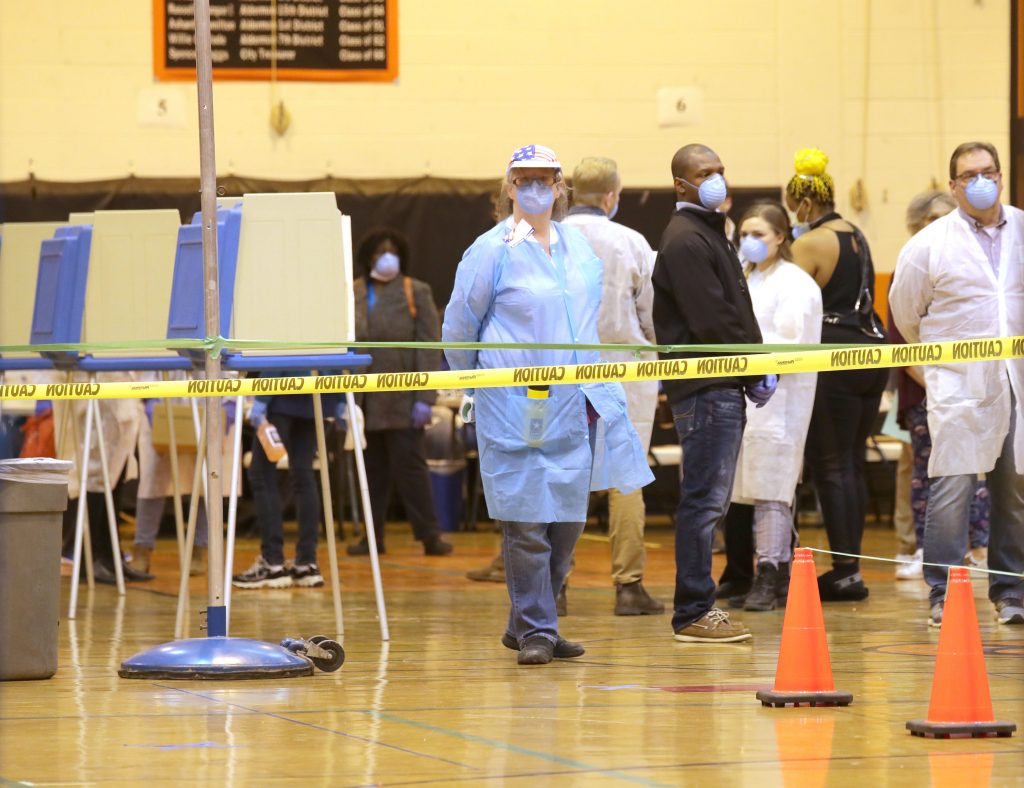
Poll Workers 
Food Bank Distributors 
Pharmacists 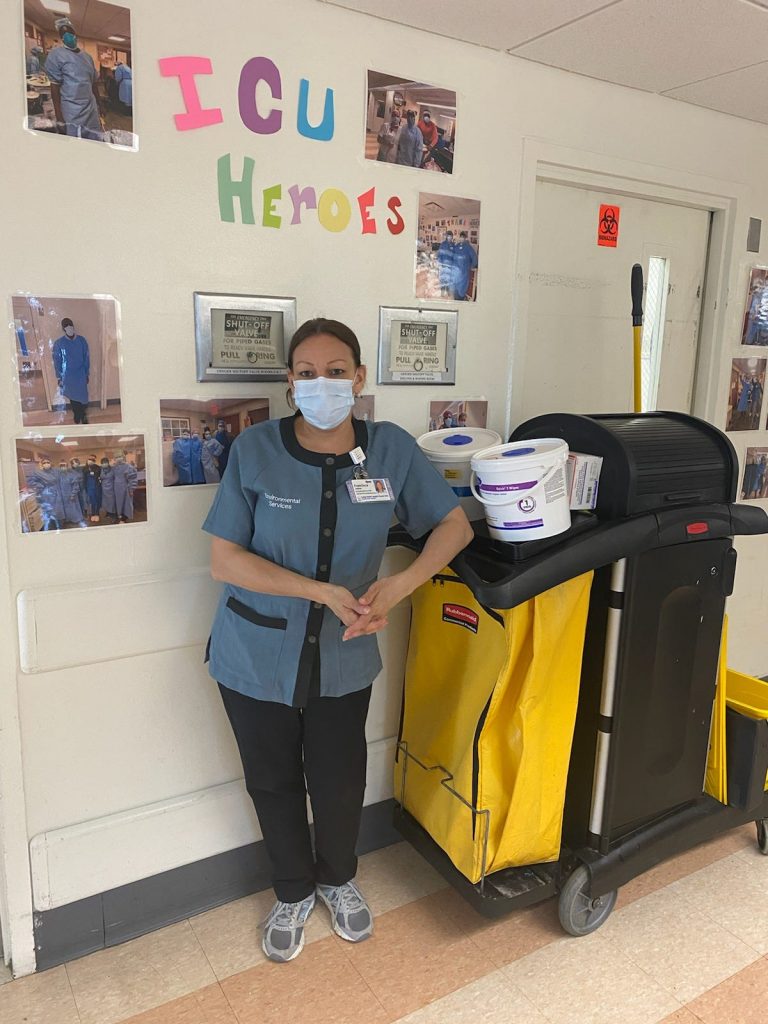
Facility Sanitation 
Utilities Maintenance 
Teaching 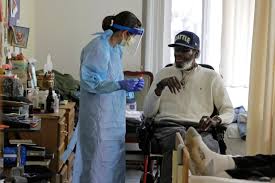
Elder Care 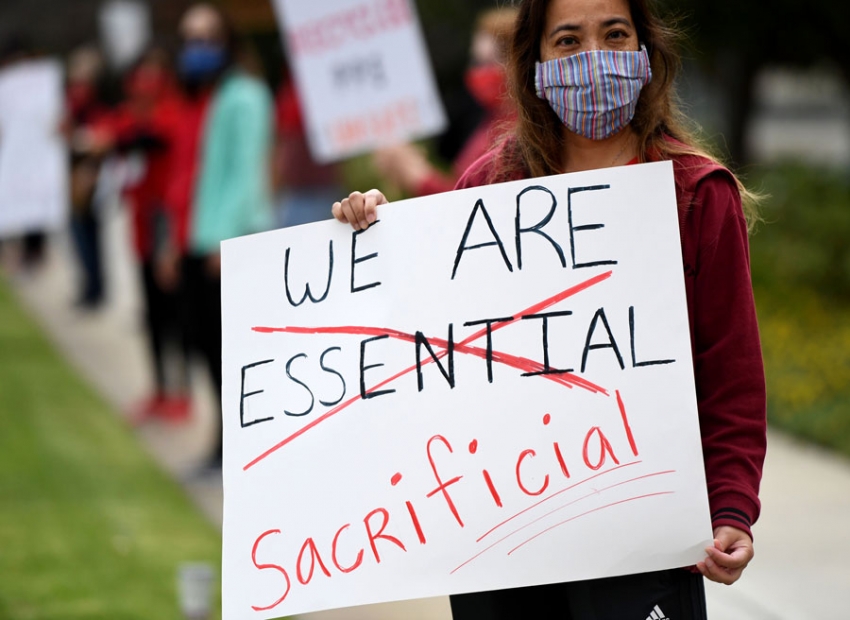
Bottom Line: Many people/characters have little or no idea of the hazards their jobs hold for their health, both short and long term. Tension, illness, and death possibilities are nearly limitless! Consider an entire family’s suffering.





